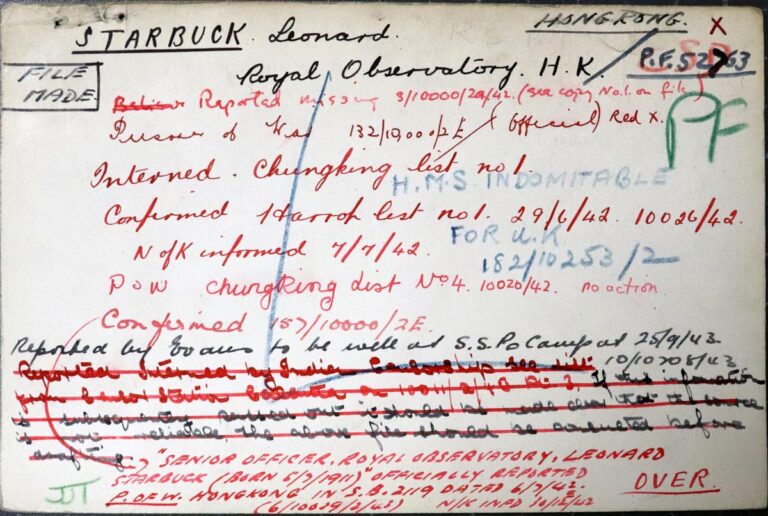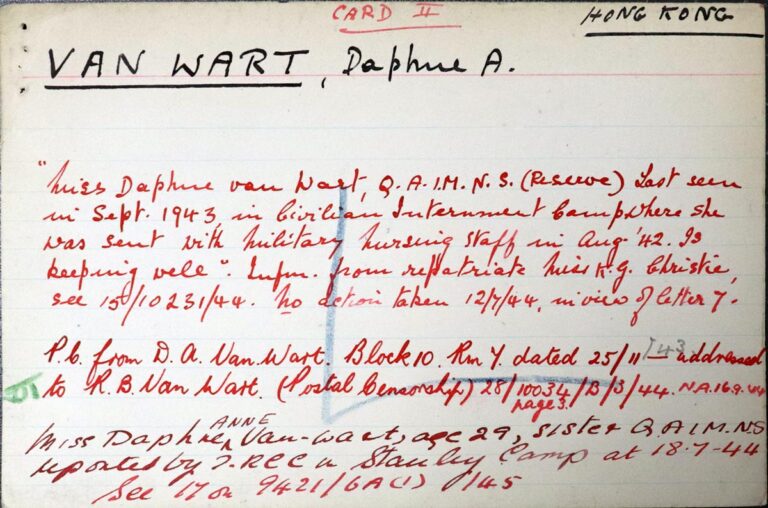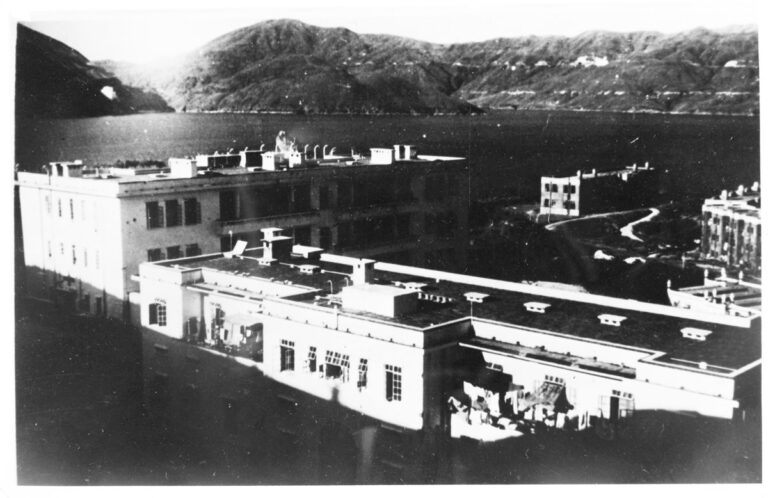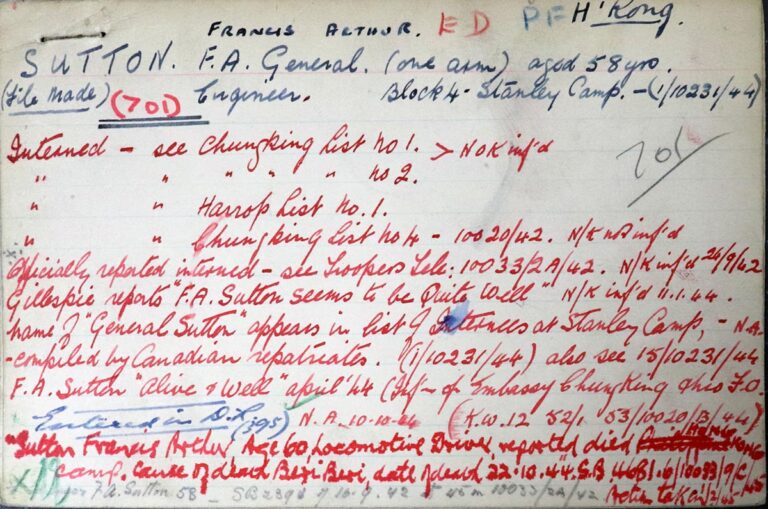Content note: This blog includes descriptions of violence during war.
Today we return our attention to a project involving a team of dedicated volunteers cataloguing records relating to British and Allied Prisoners of War during the Second World War.
In this follow up to the blog, Life and death in Hong Kong during the Second World War, volunteer Katrina Lidbetter explores a series of nominal cards that highlight the experiences of those impacted by the 1941 invasion of Hong Kong. The series has recently been catalogued by our volunteers and can now be searched by name.
– Padej Kumlertsakul, Adviser for Overseas and Defence, The National Archives
These handwritten cards, in pen, pencil and crayon, give details of death or internment often only months after the Japanese invasion of Hong Kong, which started on 8 December 1941 and lasted 18 days. They show the desperate scramble for any information about survivors in the chaos that overwhelmed the island. They are also a testimony to the courage of all those that served or fought, those that gave their lives, those that struggled to survive injury and cruel internment, and those who risked their lives to help others.
Leonard Starbuck
The speed of the Japanese invasion caught many out. Leonard Starbuck (CO 1070/7/212) and his colleague Graham Heywood (CO 1070/3/531) were working at the Hong Kong Observatory. In the event of war, they were to retrieve essential equipment form the meteorological station near Au Tau Police Station. They drove off to do this, unaware that they were in front of their own frontline. They loaded up and were preparing to leave – but they were too late. They became the first prisoners to be captured in Hong Kong. Although a civilian, Leonard was held in a prison of war (POW) camp, Sham Shui Po in Kowloon, Hong Kong.[ref]See Philip Cracknell: The Battle for Hong Kong and The Occupation of Hong Kong. And also 81 years ago: Hong Kong’s wartime diaries | Gwulo. [/ref]
Fortunately, both Leonard and Graham survived to be liberated in 1945.

Sub-Lieutenant David Legge
In the front line facing the overwhelming number of Japanese invaders were a brave force of regular troops and local volunteers. Many gave their lives, dying in battle. Others were injured. A few, like Royal Naval Sub-Lieutenant David Pounceford Legge (CO 1070/4/528), managed to escape.
David had been on Motor Torpedo Boat 11, one of the ships scuttled in the harbour to prevent its seizure by the Japanese on 26 December 1941. David and the rest of the crew, including the skipper’s dog Bruce, escaped to safety after a journey of over a thousand miles by sea and over mountains, helped by Chinese Admiral Chan Chak and the Chinese Guerillas, The East River Column. [ref]For an account, see Philip Cracknell: The Battle for Hong Kong; and The Occupation of Hong Kong. And also Ship’s dog ‘Bruce’ escaped through Japanese lines with crew of MTB 11 | Naval Matters (wordpress.com) [/ref]
Evan George Stewart
Others were captured and faced terrible years in Japanese camps. Perhaps one of the most adventurous life stories is that of Evan George Stewart (CO 1070/7/249). In 1895, at the age of three, he survived a massacre of his parents when their missionary station in China was attacked.
He was brought up in the UK by uncles and aunts, served in the First World War, reaching the rank of Major, and in 1930 returned to Hong Kong to take over from his brother as Headmaster at St Paul’s. Here, like many First World War veterans, he also served in the Hong Kong Voluntary Defence Corps.
Evan commanded 3 Company, the Machine Gun Company, which fought bravely, suffering massive casualties. Although wounded, he organised the escape of the few survivors through enemy lines. He himself was captured and managed to survive several POW camps. He was awarded the Distinguished Service Order for his bravery (WO 373/47/335).[ref]Philip Cracknell: The Battle for Hong Kong [/ref]
The Lisbon Maru
Many POWs died in camps on the island, others were transported in terrible conditions to forced labour camps elsewhere, where many more died. Perhaps most tragic of all was the fate of those POWs transported to Japan who were locked into the hold of the ship Lisbon Maru when on 1 October 1942, it was torpedoed. As the ship sank, their Japanese captors got on lifeboats but would not let their POWs out of the hold and even shot at those who managed to get out.
The Lisbon Maru is listed as the place of death on a few of the CO 1070 cards. Even rarer is the glimpse of a survivor, as we have with Royal Naval Reserve Warrant Officer William Charles Johnstone (CO 1070/4/211) who survived and was repatriated to Australia after the war.[ref]In addition, the National Archives holds several files about the sinking of the Lisbon Maru, including the subsequent war crimes trial. [/ref]
Daphne Van Wart
Amongst those interned were many nurses. Daphne Van Wart (later Ingram) was a nursing sister in the Queen Alexandra Imperial Military Nursing Service (QA) (CO 1070/7/596). She sailed to Hong Kong on the liner Empress of Australia in July 1940. Like all the nurses on the ship, she thought she was going to an exciting but safe posting. Instead, when the Japanese attacked, she was on the front line, nursing at the Bowen Road Hospital.
The medical staff continued working under bombardment and in terrible conditions as casualties mounted. On Christmas Day 1941, the day of the surrender, the Japanese moved in. Staff were not allowed to go out and retrieve casualties but were permitted to continue providing what care they could for those left.
In February 1942, the Japanese gave the nurses an hour to pack and go. The QAs went to the French Hospital at St Theresa’s in Kowloon to nurse desperately ill POW patients, many of whom died as there were so few resources to help them. Later the nurses were interned in Stanley Camp.[ref]Nicola Tyler: Sisters in Arms [/ref]

The Leipers
As battle for Hong Kong raged, the banks were designated as essential services and continued to pay out cash and take items into safe custody. Gerald Andrew (Andy) Leiper (CO 1070/4/534) was serving in the Chartered Bank whilst his wife Helen continued at her post in the War Memorial Hospital.
When the island surrendered, Andy and his colleagues Reginald Camidge and William Cruikshank were ordered by the Japanese to liquidate the bank. They were housed with their wives at the Sun Wah Hotel whilst doing this. This gave the bankers the freedom to secretly raise funds to buy food for interned staff and families at Stanley Internment Camp and for men at the POW camps.
In June 1943, they too were interned in Stanley but six months later the three were arrested, accused of listening to Allied radio broadcasts. They were held in Stanley Prison, tortured, beaten and sentenced to many years imprisonment. Although several prisoners died, they survived and were admitted to hospital in Hong Kong on the Japanese surrender in 1945.[ref]Philip Cracknell: The Battle for Hong Kong [/ref]

General Sutton
Meanwhile, by the end of January 1942, most civilians had been rounded up and interned in Stanley Camp. Whilst this camp was less bad than the POW camps and more people survived, starvation, disease and even some executions haunted the camp.
One of the characters of pre-war Hong Kong was General Francis Arthur Sutton. He was an old Etonian and engineer who had lost an arm in Gallipoli in the First World War and won the Military Cross (WO 339/33125). After the war he had tried various jobs including railway construction in Latin America, gold mining in Siberia and then became a general in a warlord’s army in China. He had retired to Hong Kong and was interned in Stanley Camp to which he had (over-optimistically!) taken his golf clubs.
His card (CO 1070/7/339) lists him as a general, engineer and locomotive driver. Sadly, dysentery and malnutrition took his toll, his eyesight failed and on 22 October 1944, he died.[ref]Philip Cracknell: The Battle for Hong Kong [/ref]

Reverend Sandbach
One of the many faith leaders in Hong Kong at the time was the Reverend Joseph (Joe) Sandbach (CO 1070/7/151), a Methodist minister and naval chaplain who ran the Sailors and Soldiers Home. He and his wife were amongst the last to arrive as internees in Stanley Camp and found no space. Then luckily, they managed to unlock the door of an overlooked cupboard-sized room, just big enough for him and his wife. It even had a bed – a rare luxury. This became their home for the next three and a half years.
When liberation finally came, after attending the formal surrender[ref]SURRENDER CEREMONY AT HONG KONG [Allocated Title] | Imperial War Museums (iwm.org.uk) [/ref] , Joe Sandbach was asked to stay to help allocate internees to ships. John Taylor, a former Merchant Navy officer (CO 1070/7/405), agreed to stay and help too.
Stanley Camp was rapidly emptied as internees were repatriated, usually by ship and some by air. The details of these journeys are scrawled in crayon on some of the CO 1070 cards but cannot convey the huge relief that the internees must have felt. Sandbach and Taylor were the last to leave the camp, closing the gates behind them.[ref]Philip Cracknell: The Battle for Hong Kong [/ref]
Despite their terrible suffering, some of those who had lived in Hong Kong before the war, after a period of recovery, returned to Hong Kong to resume their former lives. Perhaps the reality of a dark cold winter in England, rationing and unemployment, were factors. They include the Reverend Joe Sandbach; Leonard Starbuck, who became Assistant Director of the Royal Observatory; Evan George Stewart who reopened St Paul’s College and was Headmaster again; and Andy Leiper who returned to the Chartered Bank with his wife Helen. Helen’s health however never recovered, and she died in 1947. Andy later married Sybil Swift another Stanley Camp Internee.[ref]Philip Cracknell: The Battle for Hong Kong [/ref]
Find out more
Find out more about Second World War internment records at our free exhibition Great Escapes: Remarkable Second World War Captives. Open until 21 July, Great Escapes explores the human spirit of hope and resilience during times of captivity, revealing both iconic and under-told stories of prisoners of war and civilian internees during the Second World War.
We’ve also scheduled a season of special events to accompany the exhibition that are available to book.
Further reading
There are many records, accounts and books about Hong Kong in the Second World War. The references below indicate those I specifically drew on for background information: